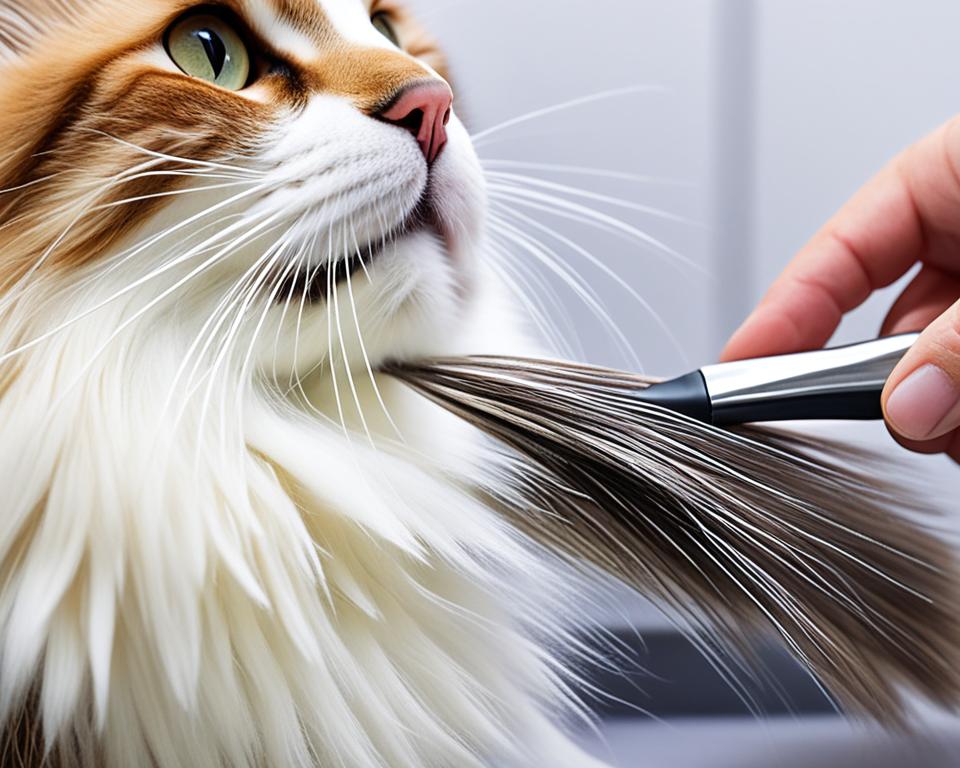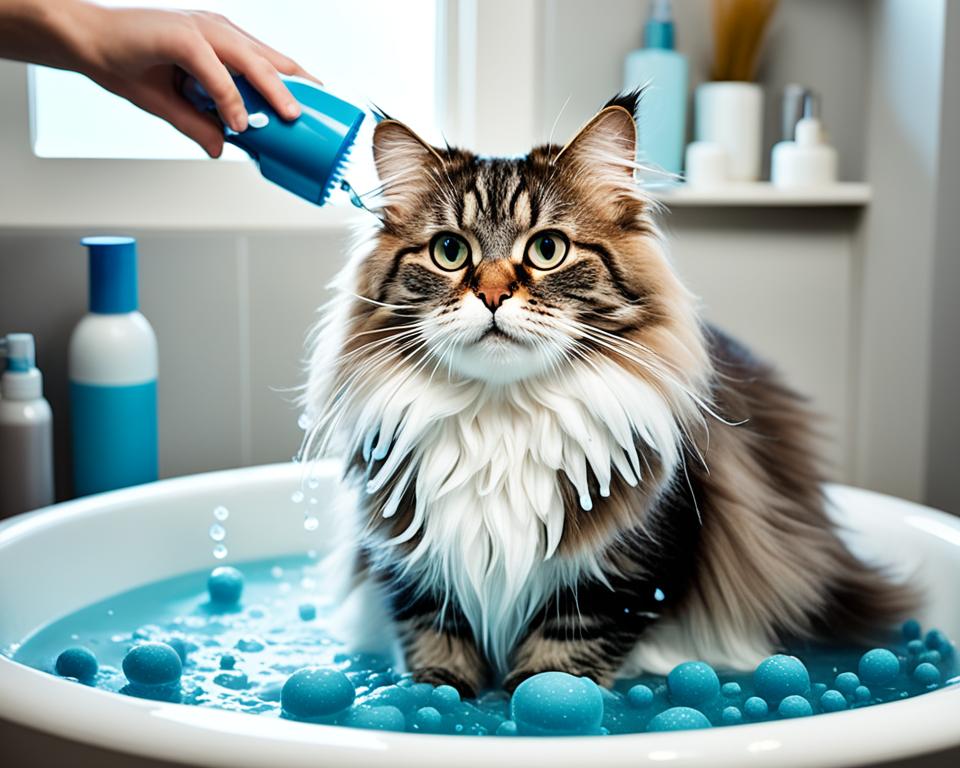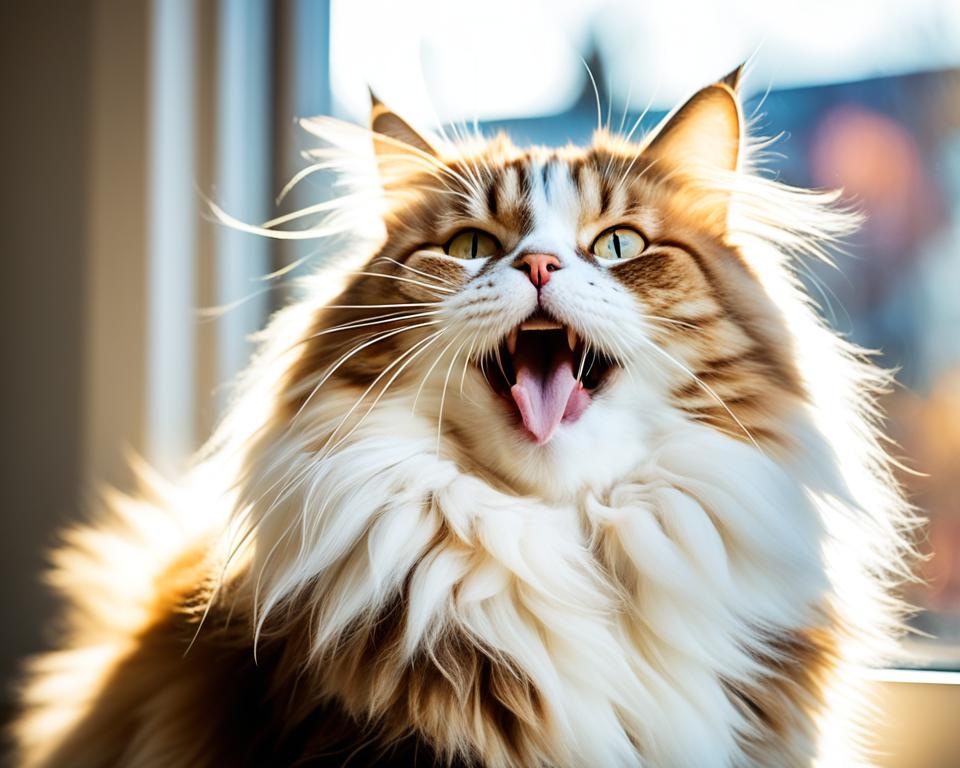I love long-haired cats, but they need special care. Regular grooming keeps them healthy and happy. It’s not just for looks; it’s vital for their health.
Grooming stops mats and hairballs. It lets me check for health problems. Different breeds need different grooming schedules. Persians need daily care, while others might be okay with grooming twice a week.
Over time, I’ve learned many grooming tips. Be gentle and patient, especially with sensitive spots. Short, positive sessions are best. With care, grooming can bring us closer.
Understanding Long-Haired Cat Coats

Long-haired cats are truly beautiful. But, they need special care for their grooming. It’s not just about brushing. It’s about knowing their coat types and needs.
Types of Long-Haired Coats
Not all long-haired cats have the same coat. Breeds like Persian, Maine Coon, and Ragdoll have different textures. Some have silky fur, while others have thicker, plush coats. Knowing these differences helps with proper grooming.
| Coat Type | Breeds | Grooming Needs |
|---|---|---|
| Silky | Persian | Daily brushing, prone to matting |
| Thick | Maine Coon | Frequent brushing, shed heavily |
| Medium-Long | Ragdoll | Regular brushing, less prone to matting |
Challenges of Long-Haired Cats
Long-haired cats have special grooming challenges. Matting is a big problem, which can cause skin issues if ignored. It’s important to prevent hairballs since they swallow a lot of fur. Owners must work hard to reduce shedding.
Benefits of Regular Grooming
Regular grooming is a must for long-haired cats. It stops matting, cuts down on shedding, and reduces hairballs. I’ve seen that regular grooming also strengthens the bond with your cat. It’s a chance to check for any skin problems too.
“Grooming your long-haired cat isn’t just about beauty; it’s a vital part of their health and well-being.”
Understanding long-haired cat coats helps you care for your cat better. Remember, patience and consistency are key in grooming long-haired cats.
Essential Grooming Tools for Long-Haired Cats
Having the right tools is key for cat grooming. For long-haired cats, daily brushing keeps their coats healthy and free of tangles. Let’s look at the must-have tools for brushing cat fur well.
The slicker brush is a top choice for removing loose fur and preventing mats. Its thin wire teeth work gently through the coat. For deeper tangles, a wide-toothed comb is perfect without causing pain.
Here’s a quick rundown of must-have grooming tools:
- Slicker brush for daily use
- Wide-toothed comb for detangling
- De-matting tool for stubborn knots
- Cat-specific shampoo for occasional baths
- Nail clippers for paw care
The FURminator is a must for reducing shedding. It comes in various sizes to reach the undercoat safely. For gentle grooming, the Furbliss brush is great. It suits both short and long hair, making it easy to pick the right one.
Every cat is different. What works for one might not work for another. I always suggest trying different tools to see what your cat likes. With the right tools, grooming will be easy and your long-haired cat will look great!
How to Groom a Long-Haired Cat

Grooming a long-haired cat takes patience and the right techniques. It’s important to have a routine. This keeps your cat looking great.
Brushing Techniques
Brushing your cat every day is key. Start at the top and go down to the undercoat with gentle strokes. A wide-tooth brush is good for most cats. But Persians and Maine Coons might need special brushes.
Pay extra attention to areas that easily get matted. This includes behind the ears, tail, and underarms.
Dealing with Mats and Tangles
Removing mats can be hard. Use your fingers or a fine-toothed comb to gently work through tangles. Start at the tips and move towards the skin.
If mats are really tough, a mat splitter tool or detangling solution can help. Sometimes, you might need to trim mats, but always think about your cat’s comfort first.
Trimming and Maintenance
Trimming your cat regularly keeps them looking neat. Focus on areas like the anus, paw pads, and around the tail. Quiet clippers make the process easier for your cat.
After trimming, a lukewarm bath with cat-specific shampoo is good. Then, dry them thoroughly.
Following these grooming tips will keep your long-haired cat’s coat healthy and beautiful. Remember, be patient and use positive reinforcement. This makes grooming a good experience for you and your cat.
Bathing Your Long-Haired Cat

Bathing cats with long hair can be tough. But, with the right tips, it’s doable. Long-haired cats need baths now and then, not too often.
Pre-Bath Preparation
First, I brush my cat to get rid of tangles. This makes bathing smoother and stops mats. Then, I trim their nails to keep them safe.
Playing with your cat before bath time can help. It makes them more relaxed during the bath.
Bathing Process
I put about 4 inches of warm water in the tub. A rubber mat keeps them from slipping. I use a pitcher to wet their fur, being careful around the face.
It’s important to use cat-specific shampoo. Human shampoo can hurt their skin. I mix the shampoo with water to make it easier to apply and rinse.
Post-Bath Care
After washing, I gently clean my cat’s face with a damp cloth. Drying them with a towel is best, as they don’t like hair dryers. I comb their fur when it’s damp and again when dry to stop mats.
This keeps their fur healthy and easy to manage.
| Bathing Frequency | Benefits | Tools Needed |
|---|---|---|
| Every 4-6 weeks | Reduces hairballs | Cat shampoo |
| As needed for dirt | Minimizes matting | Rubber mat |
| After harmful contact | Improves coat health | Wide-tooth comb |
Addressing Common Grooming Challenges
Dealing with long-haired cats has its challenges. Things like severe matting, cats that don’t like grooming, and lots of shedding are common. If mats are bad, get help from a pro groomer or vet. They have the right tools and methods to remove mats safely.
For cats that don’t like grooming, I split grooming into short parts. Brushing for five minutes, then giving treats, works great. This makes grooming a positive thing for cats. For cats that shed a lot, daily brushing and a good diet with omega-3 fatty acids helps.
Here’s a quick guide to common grooming challenges and solutions:
| Challenge | Solution |
|---|---|
| Severe matting | Consult a professional groomer |
| Reluctant cat | Use treats and short sessions |
| Excessive shedding | Daily brushing and diet improvement |
| Hairball issues | Regular brushing and hairball prevention treats |
Preventing cat hairballs starts with regular grooming. Brushing removes loose fur, so your cat swallows less during grooming. This simple step can greatly reduce hairball problems.
Professional Grooming vs. Home Grooming
Both professional and home grooming have their benefits for long-haired cats. Professional groomers are great for tricky situations like severe matting or if your cat is anxious. They have the right tools and techniques to make grooming easier. They can safely trim nails and shave your cat, which might be hard to do at home.
Home grooming lets you take care of your cat more often and strengthens your bond. It’s a chance to check for fleas, watch your cat’s weight, and look for skin problems. I think mixing both professional and home grooming is best for your cat’s health.
Brush your long-haired cat a few times a week at home. Then, have a professional groomer for deep cleaning and coat care every now and then. This mix can really help your cat stay healthy.
Every cat is different. Whether to groom at home or professionally depends on your cat’s personality, where it lives, and its coat type. If you’re not sure what grooming schedule is best, talk to your vet. They can give you advice and help you make a grooming plan that keeps your cat happy and healthy.

